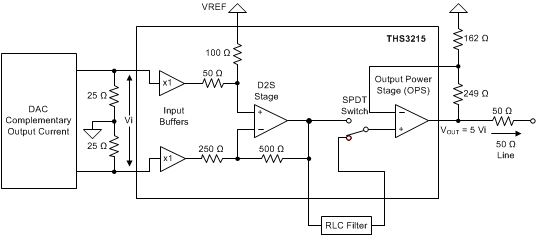SBOS780C March 2016 – June 2021 THS3215
PRODUCTION DATA
- 1 Features
- 2 Applications
- 3 Description
- 4 Revision History
- 5 Pin Configuration and Functions
-
6 Specifications
- 6.1 Absolute Maximum Ratings
- 6.2 ESD Ratings
- 6.3 Recommended Operating Conditions
- 6.4 Thermal Information
- 6.5 Electrical Characteristics: D2S
- 6.6 Electrical Characteristics: OPS
- 6.7 Electrical Characteristics: D2S + OPS
- 6.8 Electrical Characteristics: Midscale (DC) Reference Buffer
- 6.9 Typical Characteristics: D2S + OPS
- 6.10 Typical Characteristics: D2S Only
- 6.11 Typical Characteristics: OPS Only
- 6.12 Typical Characteristics: Midscale (DC) Reference Buffer
- 6.13 Typical Characteristics: Switching Performance
- 6.14 Typical Characteristics: Gain Drift
- 7 Parameter Measurement Information
-
8 Detailed Description
- 8.1 Overview
- 8.2 Functional Block Diagram
- 8.3 Feature Description
- 8.4 Device Functional Modes
-
9 Application and Implementation
- 9.1
Application Information
- 9.1.1
Typical Applications
- 9.1.1.1 High-Frequency, High-Voltage, Dual-Output Line Driver for AWGs
- 9.1.1.2 High-Voltage Pulse-Generator
- 9.1.1.3 Single-Supply, AC-Coupled, Piezo Element Driver
- 9.1.1.4 Output Common-Mode Control Using the Midscale Buffer as a Level Shifter
- 9.1.1.5 Differential I/O Driver With independent Common-Mode Control
- 9.1.1
Typical Applications
- 9.1
Application Information
- 10Power Supply Recommendations
- 11Layout
- 12Device and Documentation Support
- 13Mechanical, Packaging, and Orderable Information
3 Description
The THS3215 combines the key signal-chain components required to interface with a complementary-current output, digital-to-analog converter (DAC).
The flexibility provided by this two-stage amplifier system delivers the low distortion, dc-coupled, differential to single-ended signal processing required by a wide range of systems.The input stage buffers the DAC resistive termination, and converts the signal from differential to single-ended with a fixed gain of 2 V/V. The differential to single-ended output is available externally for direct use, and can also be connected through an RLC filter or attenuator to the input of an internal output power stage (OPS). The wideband, current-feedback, output power stage provides all pins externally for flexible gain setting.
An internal 2 × 1 multiplexer (mux) to the output power stage noninverting input provides an easy means to select between the internal differential-to-single-ended stage (D2S) output or an external input.
An optional on-chip midsupply buffer provides a wideband, low-output-impedance source for biasing during single-supply operation through the signal-path stages. This feature provides very simple biasing for single-supply, ac-coupled applications operating up to a maximum 15.8-V supply. An external input to this buffer allows for a dc error-correction loop, or a simple output dc offset feature.
A companion device, the THS3217, provides the same functional features at higher quiescent power and bandwidth. The THS3215 and THS3217 support the emerging high-speed Texas Instruments DACs for AWG applications, such as the DAC38J82.
| PART NUMBER | PACKAGE | BODY SIZE (NOM) |
|---|---|---|
| THS3215 | VQFN (16) | 4.00 mm × 4.00 mm |
 Gain = 5 V/V, Differential-to-Single-Ended Line Driver With Optional External
Filter
Gain = 5 V/V, Differential-to-Single-Ended Line Driver With Optional External
Filter